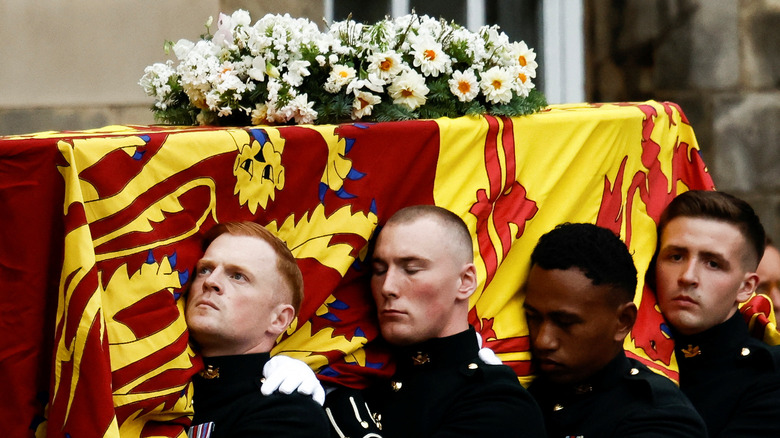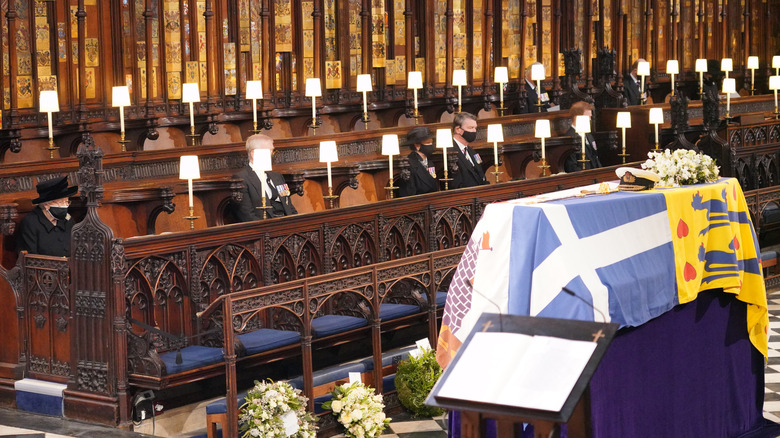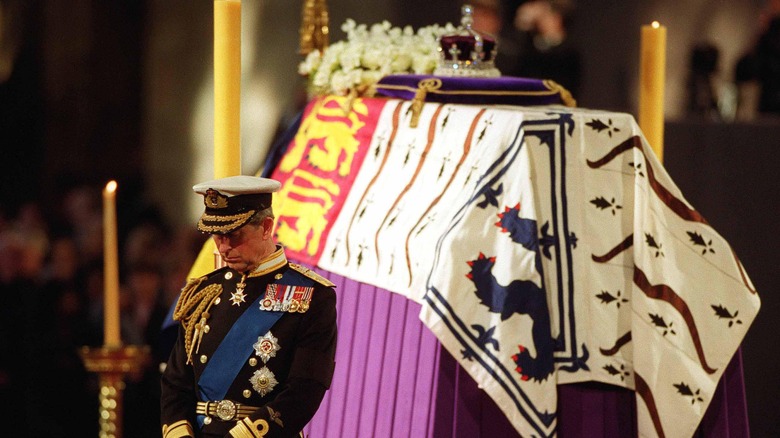Royal Coffins Are Heavier Than You'd Think
Following the death of Queen Elizabeth II on September 8, 2022, the United Kingdom entered a 10-day mourning period. During this time, her coffin made its way from Scotland to London, using a variety of transport, including a hearse, plane, and gun carriage. At points, the Queen's coffin has been lifted by pallbearers. In Scotland, eight soldiers from the Royal Regiment of Scotland carried the Queen's casket into the Palace of Holyroodhouse (via Sky News), draped in the Royal Standard of Scotland, with a wreath of freshly picked flowers from the Balmoral Estate placed on top.
As the coffin is draped in fabric, you may wonder what the royals use when saying goodbye to their loved ones. Schilling Funeral Home notes that coffins and caskets are typically made of wood like oak or mahogany, fiberglass, copper, or bronze. However, this is not the case for the royal family. Instead, they opt for something much sturdier (and heavier) than you'd think.
Members of the royal family are laid to rest in two coffins
Queen Elizabeth II's casket is made from "well-seasoned oak," according to The Telegraph, sourced from the Sandringham Estate in Norfolk. Her coffin was made more than 30 years ago by London coffin makers Henry Smith, as was Prince Philip's. The company closed in 2005, but the Queen's coffin has been in the hands of another London firm, Leverton and Sons, since 1991 (via Daily Mail). They've maintained it until now and have provided a little more insight into the precise materials used to make the coffin. "It's made from English oak, which is very difficult to get hold of," Andrew Leverton, who runs the business, explained to The Times. "Oak coffins are now made from American oak. I don't think we could use English oak for a coffin now. It would be too expensive."
Inside that oak coffin is another, much heavier casket in which the royals are laid. This one is lead-lined, which adds considerable weight for the pallbearers carrying it. So much so that the usual six pallbearers are joined by an additional two, per The Telegraph. The lead component was made via a method called "lead shell and case," where the lead is poured over the wood of the inner coffin.
Royal coffins are lead-lined for a significant reason
Following a state funeral, members of the royal family are interred in the King George VI Memorial Chapel and Vault at St George's Chapel in Windsor (via iNews). Royals have been buried under the chapel since the 15th century in the Royal Vault, but this wasn't built until the early 19th century under the reign of King George III, per Metro. His youngest daughter, Princess Amelia, was the first to be interred there.
Queen Elizabeth II will be interred in the Memorial Chapel, where her father, King George VI, and mother, Queen Elizabeth, currently reside, alongside her sister Princess Margaret's ashes. Prince Philip was initially laid to rest in the Royal Vault but will be moved to the Memorial Chapel to be interred next to his late wife (via Insider). As the royal coffins aren't buried, the lead-lining seals the coffins and helps preserve them.
As Matthew Lymn Rose, managing director of A W Lymn, The Family Funeral Service, told iNews, "If you have a coffin vault or a family chamber in a church then that coffin remains above ground and open to the elements," Matthew Lymn Rose, managing director of A W Lymn, The Family Funeral Service, told iNews. "A sealed coffin is very important." This is especially so in the UK, as the law states that any coffin interred above ground must be sealed, per Metro.


